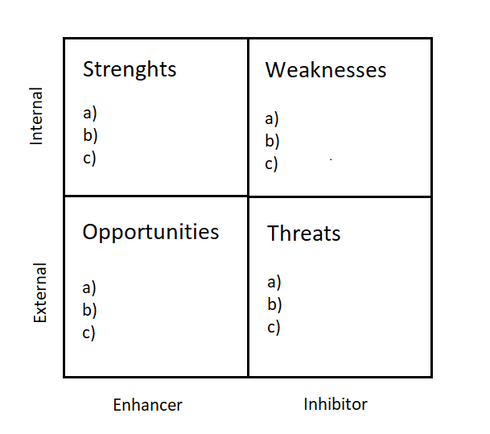SWOT Analysis
(→Conventional SWOT Analysis) |
(→Conventional SWOT Analysis) |
||
| Line 16: | Line 16: | ||
== Conventional SWOT Analysis == | == Conventional SWOT Analysis == | ||
Often, the SWOT-Analysis is being executed without examining the interdependencies between these attributes.<ref name=HBOIP/> In this “Conventional SWOT”, the two dimensions “Strengths” and “Weaknesses” are categorized as internal factors and “Opportunities” and “Threats” as external factors. For the SWOT, a 2-by-2 matrix is commonly used as a structure. | Often, the SWOT-Analysis is being executed without examining the interdependencies between these attributes.<ref name=HBOIP/> In this “Conventional SWOT”, the two dimensions “Strengths” and “Weaknesses” are categorized as internal factors and “Opportunities” and “Threats” as external factors. For the SWOT, a 2-by-2 matrix is commonly used as a structure. | ||
| + | [[File:Conventional SWOT Matrix.png|thumb|right|upright=2.7|Figure1: Conventional SWOT Matrix <ref name=CSM/>''.]] | ||
The advantages of this simplified analysis are that each factor can be examined individually with still having a holistic view on the matter. Additionally, this way of executing SWOT is faster and easier.<ref name=HBOIP/> On the other hand, the analysis is less broad and deep and the interdependencies and synergies are getting ignored. | The advantages of this simplified analysis are that each factor can be examined individually with still having a holistic view on the matter. Additionally, this way of executing SWOT is faster and easier.<ref name=HBOIP/> On the other hand, the analysis is less broad and deep and the interdependencies and synergies are getting ignored. | ||
Revision as of 10:56, 11 February 2021
Developed by Henning Duwe
SWOT is a commonly used method that helps to systematically analyze a topic by dividing it into the four categories “Strengths”, “Weaknesses”, “Opportunities” and “Threats” to examine their influence [1] and how these attributes interact with each other. It can be described as a technique for Situation [2] or Data Analysis [3] or as a tool for “identifying, relating, and making performance improvement decisions within context.”[2]
Contents |
Introduction
The Dimensions of SWOT
SWOT can be executed in different ways, but they all share the view on internal and external enhancers and inhibitors of organizational performance.[2] At the beginning of the analysis, strengths and weaknesses of the specific organization, project or the whole business area are identified. The next step is detecting which opportunities and which threats result from this.[3] The four dimensions of the analysis can be defined as follows:
- Strength: an internal enhancer of competence, a valuable resource, or attribute
- Weakness: an internal inhibitor of the competence, resources, or attributes necessary for success
- Opportunity: an external enhancer of performance that can be pursued or exploited to gain benefit
- Threat: an external inhibitor of performance that has the potential to reduce accomplishments [2]
Conventional SWOT Analysis
Often, the SWOT-Analysis is being executed without examining the interdependencies between these attributes.[2] In this “Conventional SWOT”, the two dimensions “Strengths” and “Weaknesses” are categorized as internal factors and “Opportunities” and “Threats” as external factors. For the SWOT, a 2-by-2 matrix is commonly used as a structure.

The advantages of this simplified analysis are that each factor can be examined individually with still having a holistic view on the matter. Additionally, this way of executing SWOT is faster and easier.[2] On the other hand, the analysis is less broad and deep and the interdependencies and synergies are getting ignored.
Advanced SWOT Analysis
The SWOT analysis structures the different causes of the strengths, weaknesses etc. especially due to their urgency for action.[1] But it also examines to which degree the strengths of the organization could offset the threats and determines if the weaknesses possibly restrain the opportunities.[3]
Strengths, Weaknesses, Opportunities and Threats which have the same cause can be put into groups since they probably need the same or similar actions. For each of the four fields in the matrix a basic approach can be defined: - Strengths/opportunities: build on strengths and use opportunities - Strengths/threats: build on strengths and minimalize threats - Weaknesses/opportunities: repair weaknesses and use opportunities - Weaknesses/threats: repair weaknesses and minimalize threats[1] For each of these segments, an own evaluation is made. The ultimate goal is to have an overview of the issue from the most important perspectives and therefore have a basis for upcoming decisions under uncertainty. One of the strengths of SWOT is that it raises attention to the context, in which the results of the decision will be implemented. In a traditional SWOT analysis, contextual factors like an increasing market fragmentation categorized as a threat are classified and discussed by the participants. By doing so, a better understanding of the context can be accomplished. [2]
Discussion
Annotated Bibliography
References
- ↑ 1.0 1.1 1.2 Zuest, Rainer and Troxler, Peter. No More Muddling Through, 2006. Springer.
- ↑ 2.0 2.1 2.2 2.3 2.4 2.5 2.6 Watkins, Ryan and Leigh, Doug. Handbook of Improving Performance in the Workplace, 2010. Pfeiffer.
- ↑ 3.0 3.1 3.2 Zuest, Project Management Institute. Guide to the Project Management Body of Knowledge, 2017. Project Management Institute .
- ↑ Cite error: Invalid
<ref>tag; no text was provided for refs namedCSM